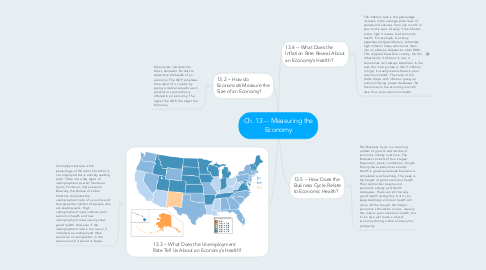Ch. 13 -- Measuring the Economy
by TUCKER LEHR

1. 13.2 -- How do Economists Measure the Size of an Economy?
1.1. Economists calculate the Gross Domestic Product to determine the health of an economy. The GDP calculates the output of a country by giving a market value to each product or service that is offered in an economy. The higher the GDP, the larger the Economy.
2. 13.3 -- What Does the Unemployment Rate Tell Us About an Economy’s Health?
2.1. Unemployment rate is the percentage of the labor force that is not employed but is actively seeking work. There are a few types of unemployment as well: Structural, Cyclic, Frictional, and seasonal. Basically, the Bureau of Labor Statistics calculates the unemployment rate of a country and that gives the number of people who are seeking work. High unemployment rates indicate poor economic health and low unemployment rates usually show good health. However, if the unemployment rate is too low or if nobody was unemployed there would be no competition in the economy and it would collapse.
3. 13.4 -- What Does the Inflation Rate Reveal About an Economy’s Health?
3.1. The inflation rate is the percentage increase in the average price level of goods and services from one month or year to the next. Usually, if the inflation rate is high it means bad economic health. For example, Germany experienced hyperinflation, extremely high inflation rates, which sent them into an extreme depression after WWI. This crippled the whole country. On the other hand, if inflation is low, it sometimes isn't always beneficial. In the end, the main picture is that if inflation is high, it usually means there is poor economic health. The value of the dollar drops with inflation going up and purchasing power decreases. So the money in the economy is worth less, thus poor economic health.
4. 13.5 -- How Does the Business Cycle Relate to Economic Health?
4.1. The Business Cycle is a recurring pattern of growth and decline in economic activity over time. The Business consists of four stages: Expansion, peak, contraction, trough. During the expansion economic health is growing because business is stimulated and booming. The peak is the height of good economic health. Then contraction begins and economic activity and health decreases. There can still be very good health during this, but it can keep declining and poor health will come. At the trough, the lowest economic stimulation occurs. Usually this means poor economic health, but it can also just mean a slower economy during a time of economic prosperity.


